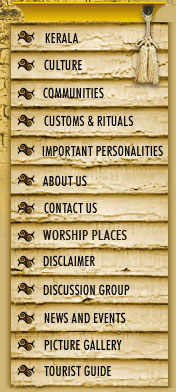|
HAVYKA BRAHMIN
“Haviya Kaviya” means homa and shraddha. Perhaps the name of Havyka Brahmin derived from the above words, as they are experts in carrying out homa and shraddha rituals. The name havik is originated from haviz (oblation) or from havu or hai, which means snake. According to the community, they were brought to kerala to perform yajna. The name of community has a mention in Skanda Purana. In their opinion, they belong to Brahmin community. It is believed that they were migrated to the other parts of the country from Ahikshetra in Bareily District of Uttar Pradesh. In Kerala they are mainly seen in Kasargode District. They speak Tulu, Kannada and Malayalam. They are divided into different gotras viz., Vishwamitra, Bharadwaj, Kashyapa, Vasista, Jamadagni and Gautam. Their surnames are Hegde, Shasthri, Sharma, Mitra, Bhat, Yaji etc. In earlier days, they follow joint family system, which later turned to nuclear families. The Havyka Brahmin is Jajurvedis. They are the followers of Sankarachaya. They worship both Lord Siva and Lord Vishnu. Traditionally they are agriculturists and cultivators dominated the community. They generally reside in valleys. They formed an association viz., “Kasaragod and Hosdurg Havyka Brahman Sabha” for the welfare of the community.
They marry within their community. Elders through negotiation arrange marriages. If horoscope agrees, betrothal (badaha) ceremony is held before the marriage takes place. In addition to betrothal, they observe another ritual known as samavarthane. The bridegroom makes an imaginary pilgrimage to Kashi (Banares) to live as a Brahmachari, but he is persuaded by his close relatives to come back and to marry the girl. On the marriage day, both the bridegroom and bride were brought to a mantap and they will stand in between a curtain. Later, after chanting mantras, the curtain is removed and garlands are exchanged. After performing the dhare ritual (pouring water to the hands of bridegroom through the bride’s), they take seven steps on rice kept at seven spots, which is known as satapadi. Then the thali is tied. Until then the girl sits on the right side of the bridegroom and only before their departure to the residence of bridegroom she sits on his left side. Thali and toe-ring are the marriage symbols of women. They observe seemantham during the seventh month of pregnancy. Birth pollution lasts for 11 days. Mango leaves are kept at the birthplace to keep evil spirits away. Namakarana is celebrated on the 11th day. The annaprasana is held in the sixth month. Chaula (mundan – tonsure) ceremony is carried out at the age of one year or before. The upanayanam is performed at the age of 9 or 11 years. They cremate dead body. The eldest son lights the pyre. Sanchayanam is held on the 3rd day. Death pollution continues for 11 days and on the 12th day pindakarma is performed and purification is done.
HEGDE
The Hegde community is seen Kasargode and Kozhikode Districts. It is believed that they were brought to Kerala from Karnataka to guard the forts of Bakel. Later they became the local chieftains. Their mother tongue is Kannada. They are categorized under Other Backward Classes. However, they consider themselves under Kshathriya category. Their traditional occupation was guarding forts and cultivation. They follow Hinduism.
Pre-delivery ritual is observed at the seventh month of pregnancy. Post delivery pollution is for 11days. Cradling ceremony and naming ceremony of the newborn baby is held on the 12th day. Annaprasanam ceremony is done on 41st day. Mundana (chaula) ceremony is observed for both males and females. Puberty rites are also observed. The girl’s parents initiate marriage. If both parties agree, muhurtha (auspicious day and time) will be fixed. On the previous day of muhurtha, the bridegroom party proceeds to the bride’s residence as a procession. On reaching the bridal dress and toe rings are handed over to the bride’s relatives. At the muhurtha, the bride and bridegroom stand facing each other and a curtain is drawn in between them. After chanting manthras, the curtain is removed and garlands are exchanged. Then the dhare ritual (pouring water to the hands of bridegroom through the bride’s) is performed. Thereafter, the bridegroom ties thali around the girl’s neck. On death, the Hegde bring the dead body to outside of the house and kept in a sitting position. After giving water to the deceased by the close relatives, the body is taken to the crematorium on a bier. The eldest son lights the pyre from the head side. On the 11th day, the eldest son collects ashes and bones from crematorium and immerses it in the river or flowing water.
HOLAYA
The Holaya are agricultural serf community and inhabited in Kasargode District. They are classified as Scheduled Caste in Kerala. They are the counterparts of Pulaya community in Kerala. ‘Pu’ in Malayalam is ‘Ho’ in Kannada and hence ‘Holaya’ in Kannada is equal to ‘Pulaya’ in Malayalam. The Holaya has 16 gotras. In past, they follow joint family system. Now nuclear families are emerged. The Holaya are hindus. They celebrate Vishu, Onam and Dussera. They are considered as the lowest among the communities in the past. Agricultural labour, mat and basket weaving are their traditional occupations. They observe pre-delivery and post-delivery rites. Puberty rites (therendu kalyanam) are also observed. Marriages are taken place either at bride’s or at bridegroom’s residence. They cremate their dead. The ashes are disposed of in flowing water and death pollution is observed for a few days.
|



